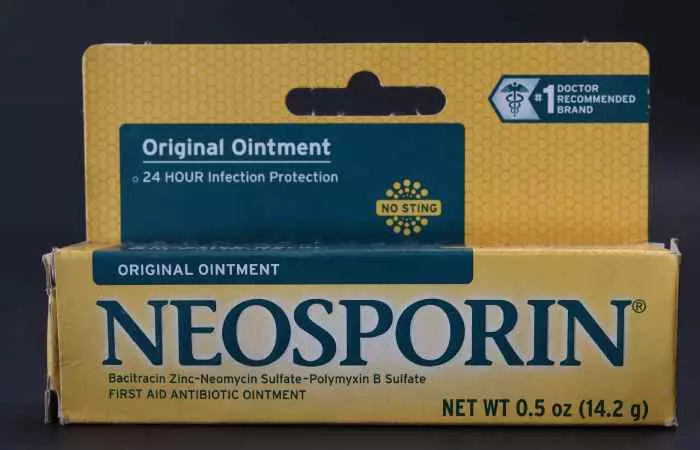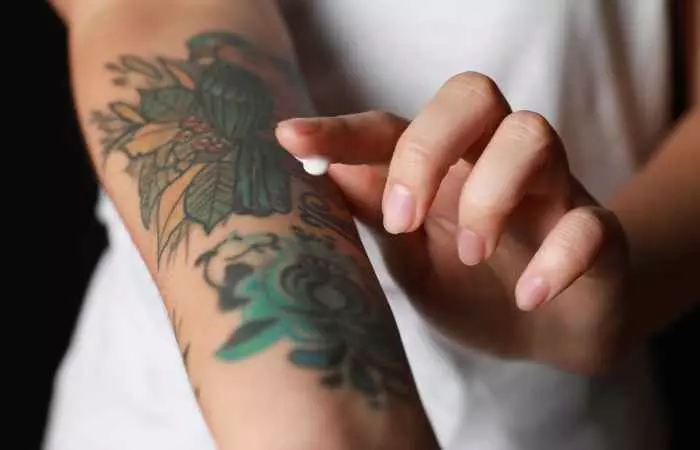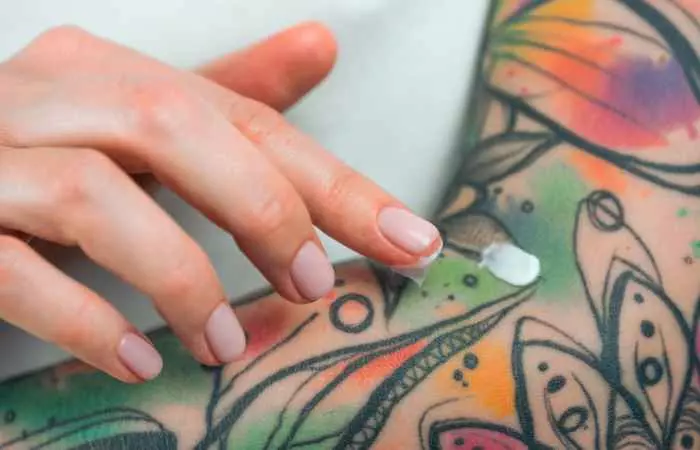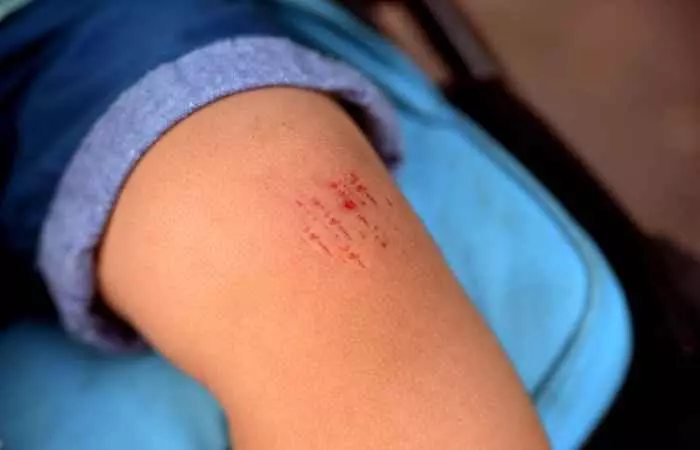
Many of us keep Neosporin in our first aid boxes for minor wounds like scrapes and cuts. It is a popular over-the-counter topical ointment known for its triple antibiotic formula. But did you know that people, of late, are also using Neosporin on tattoos? The ointment contains antibacterial ingredients like bacitracin, neomycin, polymyxin, and petroleum jelly, making it a favorite among tattoo enthusiasts. These ingredients prevent the intrusion of harmful bacteria into wounds. Since tattoos are considered wounds too, it is believed that applying a light layer of Neosporin on them may provide a protective shield that minimizes the risk of infection. But is that really the case? In this article, we help you figure out if using Neosporin on tattoos is an effective measure to safeguard them against infections. Let the scrolling begin!
Can You Use Neosporin On A Tattoo?
 Image: Shutterstock
Image: Shutterstock
Since Neosporin is meant for treating small wounds, experts recommend that you may use it for scrapes and cuts on an old tattoo. An old tattoo has healed so applying Neosporin on it would not lead to any issues. In fact, anecdotal evidence suggests that Neosporin does not have side effects such as fading the tattoo ink color when applied to old tattoos. However, is the same true for a fresh tattoo? Let us find out.
Can You Use Neosporin On A Fresh Tattoo?
Oral antibiotics are often suggested for treating and preventing bacterial infections during the healing process of a new tattoo (1). Since antibacterial ointments like Neosporin also kill bacteria, people often assume that it is okay to use them as an aftercare for fresh tattoos. However, most tattoo artists do not recommend its use for fresh as well as infected tattoos.
Despite it being seemingly logical to apply Neosporin on a healing tattoo, it is far from recommended to do so. So, does that mean you should avoid using Neosporin on tattoos altogether?
Is Neosporin Good For Tattoos?
 Image: Shutterstock
Image: Shutterstock
Ointments like Neosporin offer antibacterial ingredients like neomycin, bacitracin, and polymyxin that help kill bacteria in and around a wound. This prevents it from getting infected and promotes healing. Research suggests that these topical creams may help reduce the risk of infections in uncomplicated wounds (2). Due to this, Neosporin might be a good option for small cuts and scratches on your older tattoos. However, the same is not true for fresh inks that are still in the healing process. Though Neosporin has triple action antibacterial properties, it does not let newly tattooed skin breathe. It also does not provide your freshly inked skin with enough moisture. New tattoos need to breathe and get enough moisture in order to heal properly.

The combination of neomycin, bacitracin, and polymyxin was approved for medical use in 1971.
So, to put it simply, Neosporin may be good for old tattoos that have healed. But when it comes to healing tattoos, this antibacterial ointment may not be the best choice. Learn more below.
Why You Can’t Use Neosporin On New Tattoos
Neosporin has a thick and viscous consistency. Due to this, it forms a protective layer on the skin that prevents external elements like air and moisture from passing through it. While this barrier shields the wound against bacteria, it also prevents the passage of oxygen that is needed for wound healing (3). It also fails to provide adequate moisturization to the skin. This may slow down the tattoo healing process. Along with this, Neosporin also comes with the following side effects:
Long-term or excessive use of antibiotics is linked to their resistance (4). Research also suggests that the ingredients in Neosporin like bacitracin and polymyxin are also linked to bacterial resistance (5). Once this happens, bacteria become immune to them, leading to infections. Therefore avoid overusing Neosporin. Neosporin disrupts the skin’s natural healing process due to the limited access to oxygen (3). Anecdotal evidence suggests that this delay in wound healing may lead to scar formation.
Apart from these adverse effects, Neosporin may also lead to allergic reactions. According to a case study, a 39-year-old man with a history of HIV developed a rash on his left leg that worsened with Neosporin use. The rash spread to his body and face and he had to rush to seek medical care (6). Therefore, always perform a patch test before using the ointment and if you experience redness, itching, swelling, or rash at the application site, consult your doctor immediately.
In the case of such allergies, ask your healthcare expert for alternatives to Neosporin. Some of them are discussed in the next section.
Alternatives To Neosporin
Anecdotal evidence suggests that healing ointments like Aquaphor and A+D may be a perfect alternative to using Neosporin on tattoos. Many tattoo artists recommend using Aquaphor on new tattoos over Neosporin. Neosporin lacks the necessary components for optimal wound healing, such as adequate moisture and the availability of oxygen (3). Aquaphor, on the other hand, is recommended by numerous tattoo artists for fresh ink and even after laser tattoo removal (7). This may be because it contains soothing ingredients like glycerin that help keep the skin moisturized. The healing ointment also has anti-inflammatory benefits and allows the skin to breathe and heal faster.
However, tattoo artists only recommend using these for the first few days, following which, it is recommended to use an unscented lotion.
However, a meta-analysis of 700 American tattoo aftercare instructions suggests that these recommendations may vary depending on your tattoo artist. For instance, 14.9% of the instructions encouraged using topical antibiotics on fresh tattoos and most of them mentioned washing them with antibiotic soaps. A total of 70 different moisturizers were recommended, with 22 of them being niche tattoo-specific products. Further, only 49.9% of them stated when an individual should consult a tattooist for complications in the tattoo healing process (8). So remember to ask your tattooist for recommendations even if they don’t provide you with them!
But, does that mean it is okay to use other antibacterial ointments for tattoos? Scroll down to find out.
Can You Use Other Antibacterial Ointments For Tattoos?
 Image: Shutterstock
Image: Shutterstock
Generally it is not recommended to use any antibiotic ointment on a new tattoo unless specifically instructed by your tattoo artist or healthcare professional. This may be due to side effects like redness, itching, and pain linked to them (9). Proper care is the only Neosporin alternative you can try. Here is what you may do for it:
Follow the proper aftercare instructions given by your tattoo artist. Keep wearing the bandage applied by them for at least a few hours after your appointment. Wait for at least five hours before washing your newly inked skin with a mild, antibacterial soap and warm water. Instead of an antibacterial ointment for tattoos, opt for healing ointments like A+D and Aquaphor on the recommendation of your tattoo artist. These ointments have healing and moisturizing properties that aid skin repair. After a few days, start using a fragrance-free moisturizing lotion like Eucerin. Continue to use the lotion for at least a month until your new tattoo is completely healed. Avoid picking at your tattoo scabs. Let them fall off naturally to prevent infection and scarring.
Apart from this, reach out to your tattoo artist or a dermatologist if you notice signs of infection or adverse effects like swelling, fever, and chills. Avoid over-moisturizing your tattoo, as it may lead to infections. Only use the ointment and moisturizer as instructed by your tattooist or dermatologist.

Avoid the swimming pool until your new tattoo is fully healed, as submerging it in harsh chlorinated water may irritate the skin. If you must go swimming, use a protective, water-proof film or bandage.
While Neosporin may not be the best choice for new tattoos, you may still use it in several other situations. Check them out in the next section.
When Can You Use Neosporin On Tattoos?
 Image: ShutterstockYou can apply Neosporin to minor cuts on old tattoos. You can use it on scraped or abraded newly tattooed skin that has healed. You can apply to small, superficial burns on healed tattoos. You can use it to treat minor skin irritations, such as insect bites and chafing, on healed tattooed skin.
Image: ShutterstockYou can apply Neosporin to minor cuts on old tattoos. You can use it on scraped or abraded newly tattooed skin that has healed. You can apply to small, superficial burns on healed tattoos. You can use it to treat minor skin irritations, such as insect bites and chafing, on healed tattooed skin.
While Neosporin is easily available on the market as an over-the-counter product for minor wounds, we still recommend you consult your doctor before using it. Check out the next section for information on how you can use this ointment correctly.
How To Apply Neosporin On Tattoos
1. Clean The Wound On The Tattooed Skin
Ensure that the tattoo is completely healed before applying the antibacterial ointment. This can typically take 2 to 3 weeks. Wash your hands and clean the wound on the tattoo with a mild soap and warm water. This will remove any dirt or impurities from it. Pat the area dry with a soft and clean paper towel or cloth.
2. Apply A Thin Layer And Cover The Wound
Use a clean cotton swab to apply a light layer of Neosporin directly to the injured tattooed skin. Ensure that the entire wound is covered. You can cover the wound with a sterile bandage or dressing to prevent exposure to dirt.
3. Reapply As Needed
In general, it is often recommended to apply Neosporin two to three times a day or as directed by your healthcare provider. Ensure to stick to this frequency unless advised by a healthcare provider.
If you experience any unusual reactions, such as redness, swelling, or increased pain after Neosporin application, stop using it and seek immediate medical attention. You may also want to keep the following precautions in mind.
Precautions To Take When Using Neosporin On Tattoos
 Image: ShutterstockGet ointment and moisturizer recommendations from your tattoo artist and dermatologist before applying any product to your tattooed skin. Neosporin is generally suitable for minor wounds, cuts, and burns on healed or old tattoos. Avoid using it on large or deep wounds like fresh or infected tattoos. Check its expiration date before use and avoid contact with eyes, nose, and mouth. If accidental contact occurs, rinse it off immediately with water. Some individuals may be allergic to certain ingredients in Neosporin. If you notice redness, itching, or a rash on the tattooed skin, discontinue use and consult a healthcare professional. Since there is no evidence on the safety of Neosporin in pregnant and breastfeeding women, consult your doctor before using it on a tattoo during that time.
Image: ShutterstockGet ointment and moisturizer recommendations from your tattoo artist and dermatologist before applying any product to your tattooed skin. Neosporin is generally suitable for minor wounds, cuts, and burns on healed or old tattoos. Avoid using it on large or deep wounds like fresh or infected tattoos. Check its expiration date before use and avoid contact with eyes, nose, and mouth. If accidental contact occurs, rinse it off immediately with water. Some individuals may be allergic to certain ingredients in Neosporin. If you notice redness, itching, or a rash on the tattooed skin, discontinue use and consult a healthcare professional. Since there is no evidence on the safety of Neosporin in pregnant and breastfeeding women, consult your doctor before using it on a tattoo during that time.
Neosporin is specifically formulated for cuts, burns, and scrapes and lacks the necessary components for optimal new tattoo healing, such as moisture and breathability. As a rule of thumb, it is crucial to adhere to proper aftercare guidelines for tattoos, and using Neosporin on tattoos is generally discouraged. The only exception for this may be if you are using it to treat a minor cut or scrape on older tattooed skin. However, even for this, we recommend performing a patch test, as Neosporin may cause allergic reactions and lead to symptoms like redness and inflammation. If you experience any of these, seek medical attention immediately.
Frequently Asked Questions
Is it better to use Neosporin or Vaseline on a tattoo?
It is advisable to avoid both Neosporin and Vaseline on a fresh tattoo, as these products form a protective layer on the skin. If dust gets trapped inside this layer, it may increase the risk of infection. Further, the layer also prevents oxygen from reaching the wound, which may cause a delay in wound healing (3).
Can Neosporin fade my tattoo?
Anecdotal evidence suggests that applying Neosporin to fresh and healing tattoos may cause fading. It contains petrolatum and petroleum-based products may cause tattoo ink to fade. Therefore, it is best to avoid applying Neosporin to your tattoo.
Key Takeaways
Neosporin is an over-the-counter topical ointment that is known to treat small wounds like scrapes and cuts. Some individuals claim that this triple antibiotic formula may help with healing tattoos. However, it is not recommended. The ointment may lead to side effects like redness, inflammation, scarring, and antibiotic resistance.
Image: Dall·E/StyleCraze Design Team
Using Neosporin on tattoos is not recommended by various tattoo artists due to the adverse effects that come with it. Check out this video to learn more about why you should refrain from applying this antibiotic ointment on freshly inked skin.
Was this article helpful?
Leave a Reply